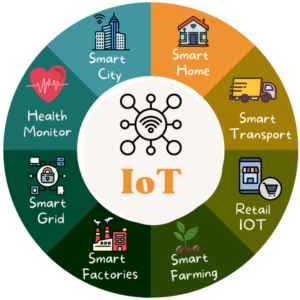Internet of Things (IoT) refers to the community of bodily devices, vehicles, appliances, and different objects embedded with sensors, software, and connectivity to alternate records over the internet. These related units can vary from clever domestic home equipment like thermostats and lights to industrial machines, wearables, and even cities’ infrastructure. The foremost purpose of IoT is to permit objects to acquire and share facts besides human intervention, enabling greater environment friendly operations and improved consumer experiences.

Key Components of IoT:
Devices/Things: Physical objects or sensors that gather data, such as clever meters, fitness trackers, or sensors in industrial equipment.
Connectivity: The way records is transmitted between devices, which ought to be Wi-Fi, Bluetooth, 5G, or different wi-fi technologies.
Data Processing and Analytics: Cloud servers or part computing structures that analyze the records gathered from gadgets and flip it into actionable insights.
Action/Response: Based on statistics processing, the device can set off actions, such as sending alerts, adjusting settings, or activating different devices.
Hyperconnectivity:
Hyperconnectivity refers to a kingdom in which individuals, devices, and structures are constantly connected, enabling non-stop verbal exchange and facts trade throughout the globe. With IoT, hyperconnectivity manifests as the seamless interplay of billions of units in real-time.
Impact of IoT and Hyperconnectivity:
Improved Efficiency and Automation: In industries like manufacturing, IoT permits automation of processes, decreasing human error and improving productivity. For example, IoT-enabled machines can predict screw ups earlier than they happen, decreasing downtime.
Enhanced Convenience: For consumers, IoT allows clever houses the place gadgets like thermostats, refrigerators, and safety structures are interconnected, enhancing ease of use and strength efficiency.
Better Decision-Making: With real-time data, agencies and governments can make knowledgeable decisions. For example, clever cities use IoT facts for site visitors management, useful resource allocation, and public safety.
Data Security and Privacy Concerns: As the whole lot turns into connected, facts privateness and protection emerge as principal concerns. A massive wide variety of units capability greater entry factors for cyberattacks.
The Role of Hyperconnectivity in IoT: Hyperconnectivity amplifies IoT’s achievable through making sure that units can talk continually and in real-time. This lets in for on the spot responses, growing smarter environments, systems, and services. For instance, in healthcare, IoT-enabled units can display affected person vitals 24/7, alerting healthcare carriers immediately in case of abnormalities.
In summary, IoT and hyperconnectivity are intently linked, as IoT drives the giant connectivity between devices, whilst hyperconnectivity ensures these gadgets are continuously changing data, growing a community of clever and responsive environments. Together, they lead to greater efficient, convenient, and dynamic structures throughout all sectors.
